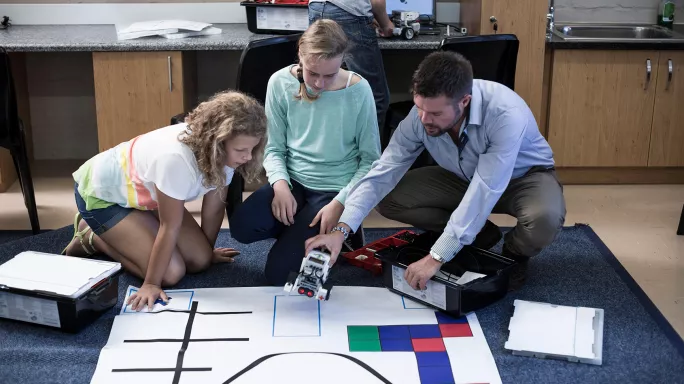
- Home
- Are we right to welcome AI into schools?
Are we right to welcome AI into schools?

We all know that ed tech is big business ( say the industry is worth around ÂŁ170 million to the UK economy) and artificial intelligence is set to be a big part of it.
In fact, it may already a bigger part of your school life than you realise.
A recent report from Nesta states that AI tools are ââ, whether itâs students using interactive online tools like or by.
Quick read:Â Artificial intelligence could ease marking burden
Quick listen:Â The truth about screen time, tech and young people
Want to know more? How can AI improve your college?
But how well do we actually understand these systems?
Many of the apps we use at home or school - like ,,Ìę ŽÇ°ùÌęClass Charts, as well as and - statistically analyse past actions and answers; these are known as training data and help AIs to adapt or predict future outcomes.
This is or; statistical pattern-recognition software.
No sentience, but statistics, replete with the vulnerabilities we learned about in GCSE maths.
We donât have or yet, thatâs the movie version (think).
A lot of AIs essentially just draw through data (or, to use the fancy term, fit a hyper-plane to an n-dimensional dataset).
Imagine the AI plotting lots of crosses on graph paper, then drawing a line of best fit through them.
If the graph were, for example, the AI might flag those students below the line as having made below average progress for their age, and refer them for extra support.
Others simply create to be able to classify things, like predicting what grades students are likely to get based on their track records. Â
Not human
AIs work rapidly and can spot patterns that humans cannot see. In 2016, AlphaZero (Googleâs AI) played a winning move in the board game Go that a grandmaster described as ââ
While this is great for gaming contexts, these AIs could also make non-human decisions about our human communities if we give them permission.

Since 2018, to .
The for-profit Behavioural Insights Team that sells the algorithm to Ofsted say that it can ââ, thus âfreeing up Ofsted employees to work with other schoolsâ.
But they donât say which factors influence outcomes the most, âpartly because they donât want schools to knowâ (and perhaps?), and also âpartly because itâs difficult to know exactly how these algorithms are workingâ.
Problems with training data
Most AIs need to be trained with examples. They identify patterns from questions answered by students, and can use these to help adapt learning pathways and predict results.
But this model presents several possible issues:
Quantity
Many adaptive personalised learning platforms claim things likeâ ŽÇ°ùÌę to bolster confidence that they have learned from plenty of student answers.
But what if most of those were answered by a minority of students, who love working online? Then all our students would be pushed along similar learning paths as those few tech-savvy students.
Provenance
If an education AI has mainly been used by inner-city schools, for example, it will not be as effective if used for predicting outcomes for students at other types of institutions.
IBMâs medical AI suggested, due to being trained on fake made up training data (because they couldnât get enough real training data).
Quality
How do we know the data is accurate? In 2011, 206 teachers in Washington DC were fired recommendations.
Investigations later revealed the abnormal student scores influencing their dismissals were likely due to cheating, enabled by other staff (who perhaps didnât want to get fired).
Bias
AIs will blindly identify patterns in the data, oblivious to ethics. In 1986, a of racial and sexual discrimination.
It had used an AI to screen applicants and the AI had quickly learned from its human predecessorsâ decisions (training data) to more readily reject people with foreign-sounding surnames and birthplaces, as well as women.
Data management
What, where and how is our data stored, and what happens when it leaves our control? Could a tired staff member inadvertently attach too much information to an email, as at (think Excel spreadsheets with hidden columns and tabs and)?
AIs can be incredibly effective in all kinds of areas of education, from with special educational needs and disabilities, to allowing students to.
We should certainly try to identify and utilise the genuinely useful educational AI products being developed.
But we need to be cautious, or we run the risk of giving away the private data of our students and staff to unsubstantiated and unaccountable black boxes, as well as handing over scarce funds for immature systems that might be the latest incarnation of the hi-tech snake-oil that.
Omar Al-Farooq is a secondary maths teacher and software engineer
Want to keep reading for free?
Register with Tes and you can read five free articles every month, plus you'll have access to our range of award-winning newsletters.
Register with Tes and you can read five free articles every month, plus you'll have access to our range of award-winning newsletters.
Keep reading for just ÂŁ4.90 per month
You've reached your limit of free articles this month. Subscribe for ÂŁ4.90 per month for three months and get:
- Unlimited access to all Tes magazine content
- Exclusive subscriber-only stories
- Award-winning email newsletters
You've reached your limit of free articles this month. Subscribe for ÂŁ4.90 per month for three months and get:
- Unlimited access to all Tes magazine content
- Exclusive subscriber-only stories
- Award-winning email newsletters